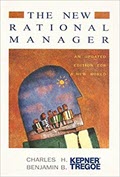In the 1960’s, Charles Kepner and Benjamin Tregoe translated a few key logical processes into simple, practical, teachable procedures. Since then, their methods have helped three generations of managers solve problems and make decisions at work. Their book, The New Rational Manager, explains their techniques. It is a classic.
To understand what Kepner and Tregoe accomplished, consider their method of “Problem Analysis,” perhaps their signature tool. It is a step-by-step procedure for determining the root cause of a problem, such as: “Why is there oil on the floor here?” “Why are sales down in this branch?” “Why is the union threatening to strike now?”
The basic method for identifying a root cause traces back to Aristotle and Francis Bacon. Abstractly, it consists of three steps: concretization, differentiation, and integration by means of causal analysis. On this abstract, descriptive level, the same process is used to discover a murderer, to identify the source of someone’s anxiety, or to find the cause of a mechanical malfunction. But such an abstract description does not provide step-by-step guidance, which many people want or need.
Kepner and Tregoe translated this abstract process into clear and simple steps, by designing a chart to capture the facts. The first column has spaces for listing factual questions to ask about the problem: What happened? Where? When? To what extent is there a problem? The second column has spaces for the answers. (The answers concretize the problem.) The third column has spaces for listing contrasting cases—cases where there is no problem. The fourth column has spaces to list what is distinctive in the problem case compared to the non-problem case. (This is differentiation.) The final column has space to list what changed. (This is the start of the causal analysis.) Kepner and Tregoe explain how to use the layout of the chart to zero-in on the root cause to complete the causal analysis.
Kepner and Tregoe captured the essential elements of a venerable logical process in a simple, straightforward procedure. I am not surprised that they can cite case after case where people used their procedure to find the root cause of a problem that had stumped everyone.
“Problem Analysis” is one of four analytical methods Kepner and Tregoe explain in their book. The other three methods are: “Decision Analysis,” “Potential Problem (or Opportunity) Analysis” and “Situation Appraisal.”
By calling these analytical methods, I mean they are methods that help one to isolate issues and to clarify the relationships between them, as the “Problem Analysis” chart does. In general, the techniques help one to organize key facts about a problem or a decision, so that drawing a conclusion is easier.
Of course, when you solve a problem, you need to do more than just analyze and organize the facts. You also need to imagine possible solutions and judge whether they are satisfactory. Similarly, when you make a decision, you need to do more than just lay out the facts. You need to invent alternate choices and judge how good they are. But as Kepner and Tregoe observe, a solid, factual analysis aids both creative thinking and good judgment.
I recommend The The New Rational Manager wholeheartedly. Its techniques are valuable both for individuals and for teams.
For an individual, this book provides a clear, no-nonsense explanation of how to analyze problems and decisions in a business context. The explanations help to clarify and simplify the conceptual steps that are logically necessary.
For a team, the book’s techniques offer an even larger value. Kepner and Tregoe report that their procedures improve communication among team members. Teams find that having a common, accepted structure for analyzing problems and decisions helps them ensure that all the relevant facts get into discussion. For example, only after pooling their information using “Situation Analysis” did one group figure out that a puzzling quality problem on a tire was actually three separate problems.
I haven’t used Kepner and Tregoe’s techniques with a group. But based on the stories told in The New Rational Manager and anecdotes I’ve heard from companies that use the methods, I am certain that the techniques are invaluable in group discussions. The logical, step-by-step procedures could transform a muddled meeting into a coherent, productive discussion. No doubt, this is an important reason for the enduring popularity of Kepner and Tregoe’s analytical techniques.
Notes:
This review is based on the 1981 edition of the book. I have not read the earlier edition (The New Rational Manager, by Charles Kepner, 1965).
In 1997, the book was re-released with the title, The New Rational Manager: An Updated Edition for a New World. I made a side-by-side comparison of the 1997 and 1981 editions, and found the differences to be insignificant.
Book Information: Charles Kepner & Benjamin Tregoe, The New Rational Manager: An Updated Edition for a New World, Kepner-Tregoe, 1997.









0 Comments